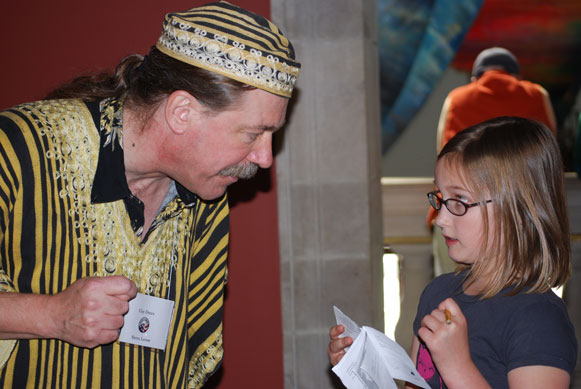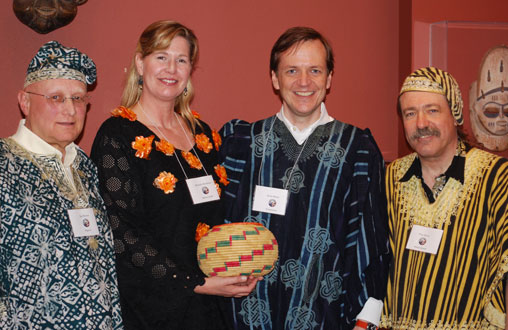By Leona Baker | March 17, 2011
 Dr. Clay Drees is decked out in black and yellow “country cloth,” a fabric woven by women from the villages of Sierra Leone, the small West African nation where Drees served as a Peace Corps volunteer from 1977-1979. A young girl approaches him armed with a “passport” and a question.
Dr. Clay Drees is decked out in black and yellow “country cloth,” a fabric woven by women from the villages of Sierra Leone, the small West African nation where Drees served as a Peace Corps volunteer from 1977-1979. A young girl approaches him armed with a “passport” and a question.
“How do people in Sierra Leone say, ‘This food is very tasty’?,” she asks.
Drees answers in Krio, the native language of Sierra Leone: “Dis chop, e sweet pass monkey-lip seff!," or “This food tastes even better than monkey lips themselves!”
Monkey lips are considered a delicacy in Sierra Leone, Drees explains. The answer elicits mixed reactions—ranging from fascination to disgust—from the young explorers engaged in a globe-trotting learning game at a special event at Norfolk’s Chrysler Museum of Art on March 12 marking the 50th Anniversary of the Peace Corps.
Drees, a professor of history at Virginia Wesleyan College, is the president and founder of Returned Peace Corps Volunteers (RPCVs) of Hampton Roads, a regional education and outreach group dedicated to one of the primary goals of the Peace Corps—“bringing the world back home.”
The RPCVs of Hampton Roads boasts approximately 80 members who served in 48 different countries around the world from the early 1960s, when President John F. Kennedy established the Peace Corps by executive order, to the present. The event at the Chrysler Museum is one of hundreds being held around the country this year in celebration of a half century of Peace Corps volunteerism, famously billed as “the toughest job you’ll ever love.”
“I think any Peace Corps volunteer will tell you that it changed their life,” Drees says of his own Peace Corps experience. “I went over a 22-year-old college grad, pretty naïve, and I came home a 24-year-old kind of veteran of the world.”
 As a teacher at a Catholic mission school in the diamond mining district of eastern Sierra Leone, Drees was exposed to some harsh realities of the human condition—from malnutrition, disease and even death to snakes and giant insects. But he walked away with a transformed view of himself and of America’s place in a diverse world.
As a teacher at a Catholic mission school in the diamond mining district of eastern Sierra Leone, Drees was exposed to some harsh realities of the human condition—from malnutrition, disease and even death to snakes and giant insects. But he walked away with a transformed view of himself and of America’s place in a diverse world.
“After two years of that, I knew I could deal with whatever life chose to throw at me, a lesson that ended up serving me well later in life,” he explains. “And I learned to respect and celebrate other cultures, instead of trying to dominate or change them.”
The Peace Corps experience has evolved over the years, of course. One big reason is technology. Many present day Peace Corps volunteers go in with laptops and cell phones—invaluable communication tools that didn’t exist in the late 1970s when Drees volunteered. But the basic missions—assisting people in need, better understanding foreign cultures and helping others to understand ours—remain.
Drees says his Peace Corps experience has definitely influenced his work in the classroom, where he teaches European, African and Islamic history. He has also become an informal recruiter for the Peace Corps during his nearly 20 years at Virginia Wesleyan, six of them as chair of the Division of Social Sciences.
“All the kids know I’m kind of the Peace Corps guy, and increasingly more and more students have become interested in the Peace Corps at Wesleyan,” he says. “It’s been very gratifying for me. When I got here in the early to mid-’90s, we put maybe one student in the Peace Corps every three or four years. Now we are typically putting between two and four students every year in the Peace Corps. So there has been a dramatic change. Students are more interested in giving back now, which is wonderful to see, and many of them are looking into the Peace Corps as a way to do that.”

